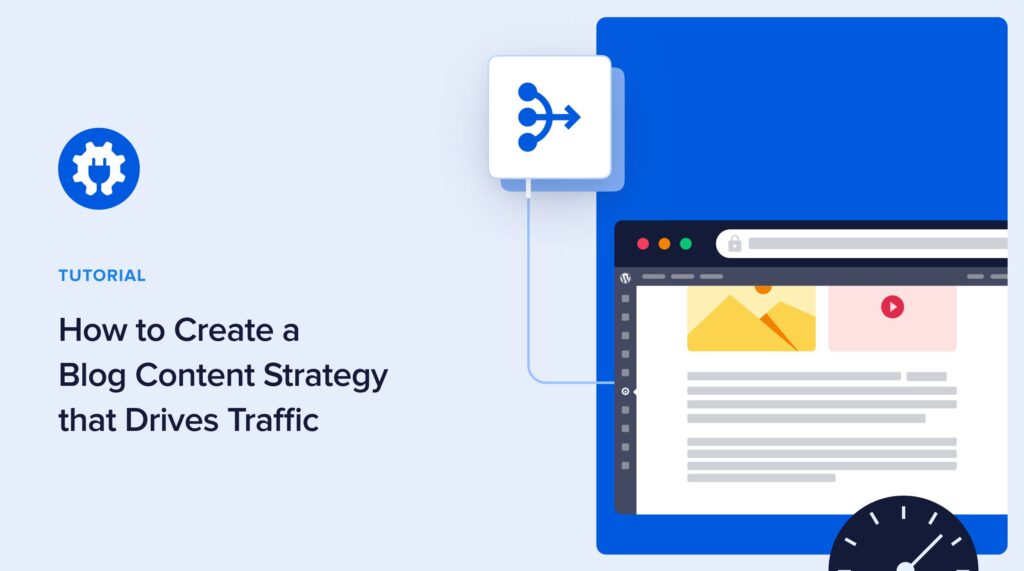Would you like to know how to create a blog content strategy that drives traffic?
In today’s digital landscape, a blog can be a powerful tool for businesses and individuals. It’s a platform to establish your expertise, connect with your audience, and ultimately, drive traffic to your website or landing page.
But simply having a blog isn’t enough. Success hinges on a well-defined blog content strategy, a roadmap that guides your every step.
This article will equip you with the knowledge and tools to create a winning blog content strategy that attracts visitors, keeps them engaged, and achieves your desired goals.
In This Article
- What is a Blog Content Strategy?
- Why is a Blog Content Strategy Important?
- How to Create an Impactful Blog Content Strategy
- 1. Use the Right SEO Tool
- 2. Define Your Goals
- 3. Define Your Core Topics
- 4. Choose the Right Content Format
- 5. Create High-Quality Content
- 6. Integrate Topic Clusters into Your Blog Content Strategy
- 7. Be Deliberate About Showcasing Google E-E-A-T
- 8. Design a Linking Building Strategy (Internal, external, backlinks)
- 9. Set a Publishing Schedule
- 10. Choose Your Promotion and Distribution Channels
- Measuring the Impact of Your Blog Content Strategy
- Blog Content Strategy: Your FAQs Answered
What is a Blog Content Strategy?
A blog content strategy is a plan that outlines your approach to content creation, publication, and promotion. It encompasses everything from defining your target audience and goals to choosing content formats, topics, and promotion methods.
This strategic approach ensures your blog isn’t just a collection of random posts but a cohesive and impactful hub that attracts the right audience and drives the results you seek.
Why is a Blog Content Strategy Important?
Having a solid content strategy offers several crucial benefits to your content marketing. Some of the most prominent ones include:
- Clarity and focus: Keeps you focused on your target audience and goals, preventing you from creating content that wanders off track.
- Increased traffic: Strategic content attracts qualified visitors genuinely interested in your offer.
- Improved engagement: Compelling content fosters engagement, encouraging readers to subscribe, comment, and share.
- Better search rankings: A well-planned blog content strategy incorporates search engine optimization (SEO) best practices, improving your visibility in search results.
- Brand building: Consistent, high-quality content establishes you as a thought leader and builds trust with your audience.
- Boosts your Google E-E-A-T signals: A well-defined blog content strategy helps you create content that meets Google’s E-E-A-T content quality standards. This results in better rankings, more traffic, and increased conversions.
As you can see, a blog content strategy is essential to the success of your digital marketing endeavors and helps bolster your online presence.
How to Create an Impactful Blog Content Strategy
Now that you know what a blog content strategy is and why it’s important, let’s quickly look into some essential components of creating one.
1. Use the Right SEO Tool
One of the first SEO tips for a successful blog content strategy is to ensure you have the right SEO tool to help your content rank. And for WordPress users, there’s no better tool than All In One SEO (AIOSEO).
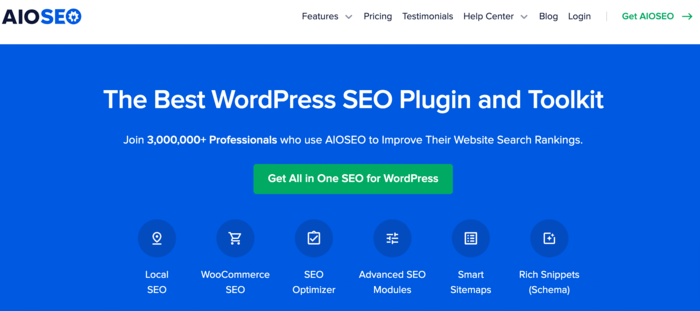
AIOSEO is a powerful yet easy-to-use SEO plugin that boasts 3+ million active installs. Millions of smart bloggers use AIOSEO to help them boost their search engine rankings and drive qualified traffic to their blogs. That’s because the plugin has many powerful features and modules designed to help you properly configure your SEO settings.
The plugin has many features designed to boost your blog content strategy. One of the first is the Author SEO module.
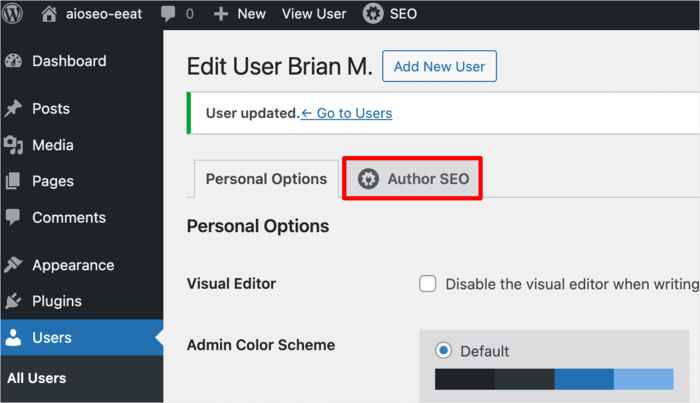
This revolutionary feature helps you demonstrate Google’s E-E-A-T content quality standards by making it easy to create optimized author bios.
You’ll also benefit from tools like the TruSEO Highlighter and TruSEO Analysis modules designed to help optimize your content.
Plus, the Cornerstone Content module will help you implement the topic cluster content strategy to help you build authority and rank higher on SERPs.
Other examples of features you’ll find in the plugin include:
- Search Statistics: This powerful Google Search Console integration lets you track your keyword rankings and see important SEO metrics with 1-click, and more.
- SEO Revisions: Track any changes you make to your site and see their impact on your SEO. Plus, you get to see on a timeline how Google updates affect your site.
- Advanced Robots.txt Generator: Easily generate and customize your robots.txt file for better crawling and indexing.
- TruSEO Highlighter: Makes it easy to spot on-page SEO issues and gives recommendations for fixing them.
- Next-gen Schema generator: This no-code schema generator enables users to generate and output any schema markup on your site.
- Link Assistant: Powerful internal linking tool that automates building links between pages on your site. It also gives you an audit of outbound links.
- SEO Preview: This gives you an overview of your search and social snippets and general SEO so you can improve your optimization.
- IndexNow: For fast indexing on search engines that support the IndexNow protocol (like Bing and Yandex).
- Sitemap generator: Automatically generate different types of sitemaps to notify all search engines of any updates on your site.
- And more.
AIOSEO also has many other features to help you boost your local SEO, on-page SEO, and technical SEO. It also has a dedicated WooCommerce SEO module for those with eCommerce stores.
For step-by-step instructions on how to install AIOSEO, check our detailed installation guide.
2. Define Your Goals
Determining your goals is a critical component of creating an impactful blog content strategy. Your content should be created to achieve a particular result for your business.
That’s why you should develop your blog content strategy around specific goals.
Some goals you can achieve using content include:
- Brand awareness
- Traffic generation
- Lead and sales generation
Once you’ve defined your goals, you’re better positioned to know what kind of content to create to achieve them.
If your goal is SEO-focused, check out our tips for setting SEO goals for more information.
3. Define Your Core Topics
Every brand should have some core topics they cover. For example, here at AIOSEO, our core topic is search engine optimization.
How do you define your core topics?
The first step to defining your topics is to discover the intersection between the value you offer and what your target audience cares about. This is crucial as it will help ensure your core topics are relevant to your target audience. Other ways of identifying your core topics include:
- Keyword research: Identify keywords relevant to your audience and goals.
- Industry trends: Stay up-to-date and write about relevant topics.
- Surveys: Analyze what resonates with your audience.
Defining your core topic will help you come up with a relevant content calendar for the content that’s a priority to your brand.
4. Choose the Right Content Format
Once you’ve defined your core topics, the next step to creating a blog content strategy that drives traffic is to determine the right content format for delivering your message. Common ones include:
- Blog posts: Versatile and evergreen, they cover various topics in detail.
- Infographics: Visually engaging summaries of complex information.
- Videos: Highly engaging and shareable, but require more resources.
- Podcasts: Great for in-depth discussions and building community.
Your target audience and the platforms on which you’ll distribute the content are critical factors in determining your content formats.
5. Create High-Quality Content
Content quality plays a huge role in helping you rank higher on SERPs. That’s why you must determine to create top-notch content. One reason for this is Google’s Helpful Content Update (HCU). After this update, content quality and relevance became even more important ranking factors.
Read our guide to understand the Helpful Content Update (HCU).
Another reason content quality is important is that readers want content that meets their needs. If yours doesn’t, they’ll quickly bounce, signaling to search engines that your content isn’t good enough to promote on SERPs.
A few tips for creating quality content include:
- Conduct in-depth topic and keyword research
- Cover the topic thoroughly
- Meet user intent/search intent
- Create scannable content
- Include statistics and facts
High-quality content helps build your credibility and online authority, elements that help improve your rankings on search engines.
6. Integrate Topic Clusters into Your Blog Content Strategy
Topic clusters are a group of content pieces created around 1 core topic. Each piece comprehensively covers its focus subject and links to a cornerstone or pillar page. Creating content this way helps build topical authority and enhance your semantic SEO. Both are great ways to rank your site and content higher, especially in a competitive niche.
Creating a topic cluster requires:
- Cornerstone content (pillar page): This is the hub of the topic cluster. It broadly covers the main subject, with each subheading briefly addressing related subtopics.
- Subtopic pages: Subtopic pages are the pieces of content you create to provide in-depth coverage of a single aspect of the main subject and link to the pillar page.
Once you’ve built your pillar pages and subtopics, create strategic internal links between them. You can automate this using AIOSEO’s Link Assistant module.
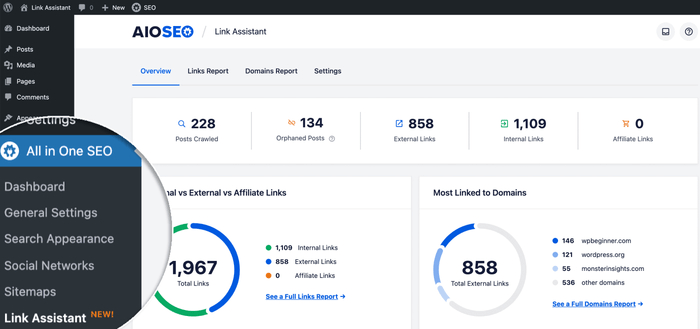
To make things easier, AIOSEO also has a Cornerstone Content feature.
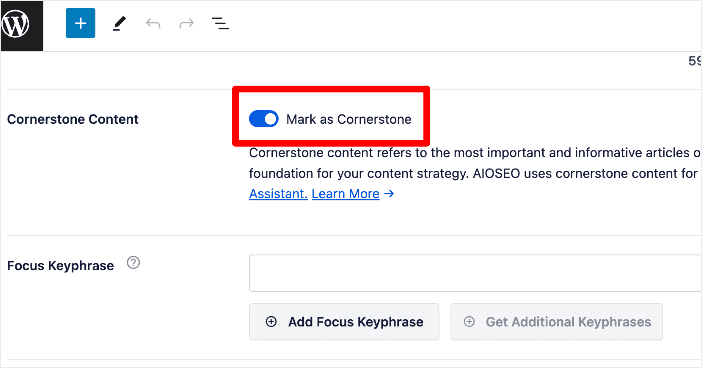
This marks your pillar pages as cornerstone content, making it easier for you to manage your topic cluster strategy.

And in Link Assistant, cornerstone content is denoted by a building icon:

All these make it a breeze to create topic clusters in WordPress.
Integrating topic clusters into your blog content strategy is a fantastic way to create smaller bite-sized content for those who prefer shorter content while meeting the needs of voracious readers.
7. Be Deliberate About Showcasing Google E-E-A-T
Google’s E-E-A-T stands for Expertise, Experience, Authoritativeness, and Trustworthiness. It is a set of content guidelines Google uses to assess the quality of content on the web. Content that demonstrates E-E-A-T stands a better chance of ranking higher on SERPs.
Note: According to Google, E-E-A-T is not a direct ranking factor.
Being deliberate about showcasing E-E-A-T content quality guidelines is easier if you have a plugin like AIOSEO. The Author SEO module makes this possible.

This module enables you to add vital and relevant information to your user profiles:

You can also add your areas of expertise:

All this information points to your experience, expertise, and authority in your field. It also enhances your credibility and trustworthiness. Plus, all this information is output as JSON schema markup, making it easier for search engines to know that you’re qualified to talk about the subject.
All this information helps you demonstrate Google E-E-A-T, resulting in improved author SEO and better rankings.
8. Design a Linking Building Strategy (Internal, external, backlinks)
Links are one of the biggest ranking factors used by search engines to determine which content to push higher on SERPs. That’s why they should be essential to your blog content strategy. The 3 types of links you should focus on are:
Internal links
These are links you build between pages on your website. They have many SEO benefits, including:
- Distributing link juice (PageRank) across your pages
- Improving crawling and indexing
- Enhancing user experience (UX)
- Increasing the number of pageviews
As mentioned, building strategic internal links is a breeze with AIOSEO’s Link Assistant. You don’t have to manually add them.
Link Assistant is a powerful link building tool that crawls your site and gives a report on all the links on your site.

It also gives you a Links Report that shows you internal linking suggestions and the orphan pages on your site.
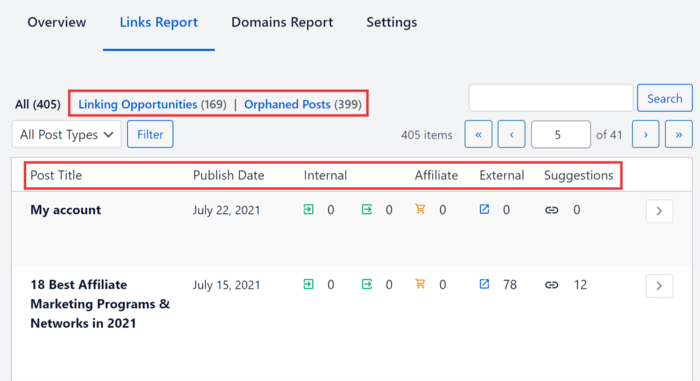
Not only does Link Assistant give you this vital data, but it helps you automatically build links between your pages. This is particularly useful for dealing with orphan pages.
The best part is you don’t even need to open a post to add the suggested internal links. You can add the links right from the Link Assistant dashboard.
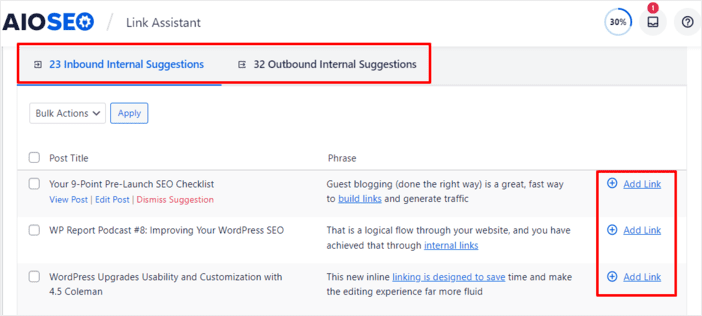
This not only improves the efficiency of your internal linking strategy but also saves you a lot of time.
Backlinks
Backlinks are links from external sites to your site and are regarded by search engines as a vote of confidence in your site and content. This is why building backlinks should be a top priority in your blog content strategy. A few ways of building backlinks include:
- Guest posting
- Listing on business directories
- Running outreach campaigns
- Getting listed on partner pages
Check out our link building guide for tips on building backlinks and external links.
Check out how Explore.com quadrupled its traffic in 10 months. One of their growth tactics was obtaining high-quality backlinks.
9. Set a Publishing Schedule
Setting a defined publishing schedule is an important part of creating a blog content strategy. In essence, this is a calendar that determines how often you publish content and when to publish.
So, how often should you publish content on your blog?
There’s no set cadence to follow, as each blog is different. However, if you’re just starting your blog, we advise starting with 1 post a week and slowly working your way up to a comfortable cadence. This will mainly depend on how much content you can produce around your core topics.
10. Choose Your Promotion and Distribution Channels
Content marketing doesn’t end when you click the publish button. If anything, this is when the marketing part starts. Marketing your content effectively requires a couple of things, including the right content marketing tools.
Apart from the right tools, you’ll also have to choose the channels you’ll use to promote and distribute your content. Again, this largely depends on your target audience and content formats. Some of the most popular content distribution channels include:
- Social media
- Content syndication platforms
- Public relations (PR) outreach
- Influencer marketing
- Guest posting
- Push notifications
Leveraging the right content distribution channels will help you get the best return on investment (ROI) out of your content strategy. This means better search rankings, more traffic, and improved conversion rates.
Measuring the Impact of Your Blog Content Strategy
Monitoring the performance of your blog content strategy is an essential aspect that can’t be overstated. Thankfully, if you’re a WordPress user, you can easily do this using AIOSEO’s Search Statistics module.
Search Statistics is a powerful Google Search Console (GSC) integration that lets you track many different SEO metrics you can use to monitor your SEO performance. Examples include your keyword rankings, content performance, and more. Let’s briefly look at a few ways you can use Search Statistics to monitor the impact of your blog content strategy.
Using the Content Performance Report
AIOSEO’s Search Statistics module includes a Content Performance report that shows how your posts and pages perform on SERPs. To access it, go to AIOSEO » Search Statistics » SEO Statistics.
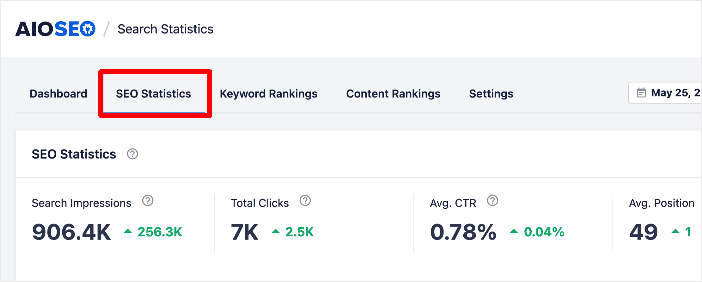
Next, scroll down to the Content Performance report.
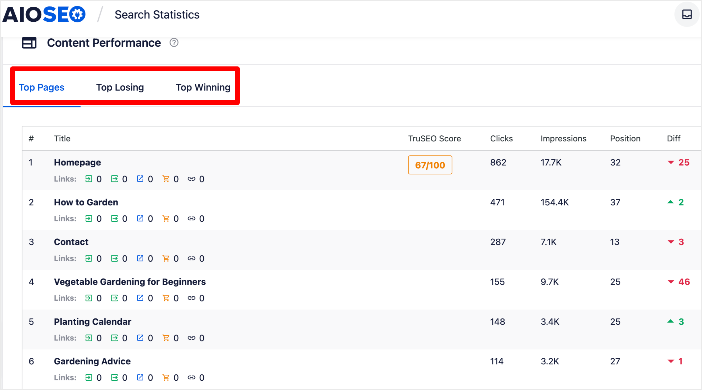
The Content Performance report shows you 3 main content metrics, namely:
- Top Pages: This shows you your best-performing pages.
- Top Losing: This shows the pages losing rankings the most.
- Top Winning: This shows the content that’s gaining higher rankings.
The Content Performance report gives you key metrics like Clicks, Impressions, Position, and Diff (change in position) for each page in this report. These give you deep insights into what’s happening to your content on SERPs.
The 2 most important metrics for measuring the performance of your SEO content are Position and Diff. The Positions tab shows each page’s position on SERPs, while the Diff shows whether your content is improving or decaying.
Blog Content Strategy: Your FAQs Answered
What is a blog content strategy?
A blog content strategy is a plan for creating and publishing blog content to help you achieve your goals. It should include your target audience, the topics you will cover, the types of content you will create, and how you will promote your content.
Why do I need a blog content strategy?
Having a blog content strategy can help you:
- Save time and energy: With a plan, you can avoid wasting time creating content that no one will read.
- Reach your target audience: By targeting your content to specific keywords and topics, you can increase your chances of attracting the right readers to your blog.
- Achieve your goals: A blog content strategy can help you increase brand awareness, drive traffic to your website, or generate leads.
We hope this post has helped you know how to create a blog content strategy that drives traffic. You may also want to check out other articles on our blog, like our guide to common SEO mistakes to avoid or our article on the benefits of SEO for small businesses.
If you found this article helpful, then please subscribe to our YouTube Channel. You’ll find many more helpful tutorials there. You can also follow us on X (Twitter), LinkedIn, or Facebook to stay in the loop.
Disclosure: Our content is reader-supported. This means if you click on some of our links, then we may earn a commission. We only recommend products that we believe will add value to our readers.
